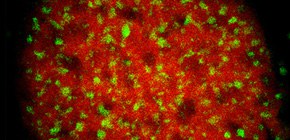
Successeful synthesis of metal oxide mesocrystals consisting of n-type and p-type semiconductor nanoparticles
Synthesis of nanocomposites by simply mixing different metal precursors!
A group of researchers led by TACHIKAWA Takashi and MAJIMA Tetsuro (Institute of Scientific and Industrial Research, Osaka University) succeeded in developing technology for synthesizing metal oxide mesocrystals consisting two kinds of metal oxide nanoparticles. The group also clarified that efficient charge transfer occurred between n -type and p -type semiconductor nanoparticles in the composite mesocrystals. This group's methodology provides insight into the creation of mesocrystals consisting of multiple metal oxides or alloyed oxides. Such newly developed mesocrystals will further increase the efficiency of energy conversion devices such as photocatalysts and solar cells.
Metal oxide nanoparticles have been used for a variety of applications; however, reduced surface area and interface misfit caused by disorganized aggregation compromised applications such as photoactivity efficiency. In order to solve these problems, the use of metal oxide mesocrystals, superstructures of self-organized metal oxide nanoparticles has been anticipated for several years. Thus far, conventional synthesis methods for constructing metal oxide mesocrystals have been complicated and synthesis took a long time and was limited to certain kinds of metal oxides.
This group developed a facile and general method for the synthesis of mesocrystals consisting of multiple metal oxides or alloyed oxides. Single-particle confocal fluorescence spectroscopy, electron paramagnetic resonance spectroscopy and time-resolved diffuse reflectance spectroscopy measurements confirmed the efficiency of photoinduced charge-transfer occurring between n-type and p-type semiconductor nanoparticles in the composite mesocrystals they created.
Seeing as this group's technology is relatively simple, enabling the construction of nanocomposites through the simple mixing of different metal precursors, its use in a wide range of applications in photovoltaics and photocatalysis is anticipated.
Abstract
The alignment of nanoparticle building blocks into ordered superstructures is one of the key topics in modern colloid and material chemistry. Metal oxide mesocrystals are superstructures of assembled nanoparticles of metal oxides and have potentially tunable electronic, optical and magnetic properties, which would be useful for applications ranging from catalysis to optoelectronics. Here we report a facile and general approach for synthesizing metal oxide mesocrystals and developing them into new nanocomposite materials containing two different metals. The surface and internal structures of the mesocrystals were fully characterized by electron microscopy techniques. Single-particle confocal fluorescence spectroscopy, electron paramagnetic resonance spectroscopy and time-resolved diffuse reflectance spectroscopy measurements revealed that efficient charge transfer occurred between n-type and p-type semiconductor nanoparticles in the composite mesocrystals. This behaviour is desirable for their applications ranging from catalysis, optoelectronics and sensing, to energy storage and conversion.

Figure 1
To learn more about this research, please read the full research report entitled " A nanocomposite superstructure of metal oxides with effective charge transfer interfaces " at this page of the Nature Communications website.
Related link
